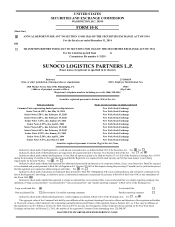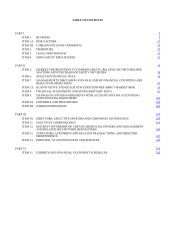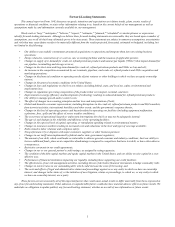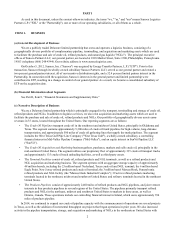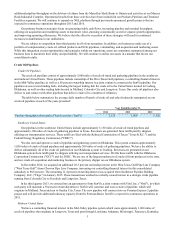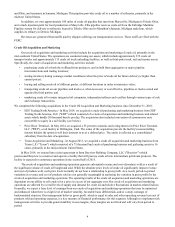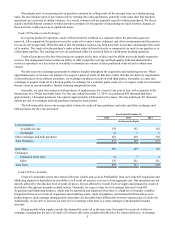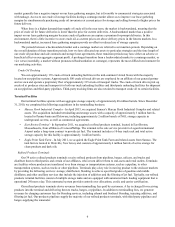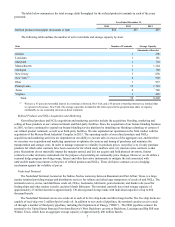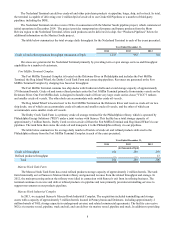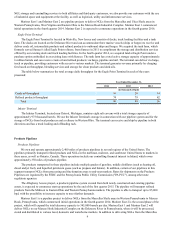Sunoco 2014 Annual Report Download - page 10
Download and view the complete annual report
Please find page 10 of the 2014 Sunoco annual report below. You can navigate through the pages in the report by either clicking on the pages listed below, or by using the keyword search tool below to find specific information within the annual report.
8
The Nederland Terminal can deliver crude oil and other petroleum products via pipeline, barge, ship, rail or truck. In total,
the terminal is capable of delivering over 2 million bpd of crude oil to our Crude Oil Pipelines or a number of third-party
pipelines, including the DOE.
The Nederland Terminal can also receive NGLs in connection with the Mariner South pipeline project, which commenced
initial operations in December 2014. The project provides transportation of propane and butane products from the Mont
Belvieu region to the Nederland Terminal, where such products can be delivered via ship. See “Products Pipelines” below for
additional information on the Mariner South project.
The table below summarizes the total average daily throughput for the Nederland Terminal in each of the years presented:
Year Ended December 31,
2014 2013 2012
Crude oil and refined products throughput (thousands of bpd) 1,233 932 724
Revenues are generated at the Nederland Terminal primarily by providing term or spot storage services and throughput
capabilities to a number of customers.
Fort Mifflin Terminal Complex
The Fort Mifflin Terminal Complex is located on the Delaware River in Philadelphia and includes the Fort Mifflin
Terminal, the Hog Island Wharf, the Darby Creek Tank Farm and connecting pipelines. Revenues are generated at the Fort
Mifflin Terminal Complex by charging fees based on throughput.
The Fort Mifflin Terminal contains two ship docks with freshwater drafts and a total storage capacity of approximately
570 thousand barrels. Crude oil and some refined products enter the Fort Mifflin Terminal primarily from marine vessels on the
Delaware River. One Fort Mifflin dock is designed to handle crude oil from very large crude carrier-class ("VLCC") tankers
and smaller crude oil vessels. The other dock can accommodate only smaller crude oil vessels.
The Hog Island Wharf is located next to the Fort Mifflin Terminal on the Delaware River and receives crude oil via two
ship docks, one of which can accommodate crude oil tankers and smaller crude oil vessels, and the other of which can
accommodate some smaller crude oil vessels.
The Darby Creek Tank Farm is a primary crude oil storage terminal for the Philadelphia refinery, which is operated by
Philadelphia Energy Solutions ("PES") under a joint venture with Sunoco. This facility has a total storage capacity of
approximately 3 million barrels. Darby Creek receives crude oil from the Fort Mifflin Terminal and Hog Island Wharf via our
pipelines. The tank farm then stores the crude oil and transports it to the Philadelphia refinery via our pipelines.
The table below summarizes the average daily number of barrels of crude oil and refined products delivered to the
Philadelphia refinery from the Fort Mifflin Terminal Complex in each of the years presented:
Year Ended December 31,
2014 2013 2012
(in thousands of bpd)
Crude oil throughput 154 258 293
Refined products throughput — — 13
Total 154 258 306
Marcus Hook Tank Farm
The Marcus Hook Tank Farm has a total refined products storage capacity of approximately 2 million barrels. The tank
farm historically served Sunoco's Marcus Hook refinery and generated revenue from the related throughput and storage. In
2012, the main processing units at the refinery were idled in connection with Sunoco's exit from its refining business. The
terminal continues to receive and deliver refined products via pipeline and now primarily provides terminalling services to
support movements on our products pipelines.
Marcus Hook Industrial Complex
In 2013, we acquired Sunoco's Marcus Hook Industrial Complex. The acquisition included terminalling and storage
assets with a capacity of approximately 3 million barrels located in Pennsylvania and Delaware, including approximately 2
million barrels of NGL storage capacity in underground caverns, and related commercial agreements. The facility can receive
NGLs via marine vessel, pipeline, truck and rail, and can deliver via marine vessel, pipeline and truck. In addition to providing

